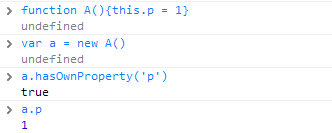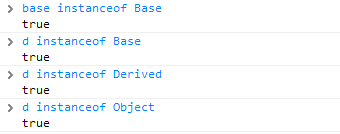
( continued from ) Let’s first look at a picture that is not new to veterans but very interesting to newbies:

What the heck is that? It’s just lun lun.
new
Putting aside the above picture, let’s take a look at the second question left in the previous article. Let’s add something to the function body of the constructor and see what happens.
<div>
<!--<br /><br />Code highlighting produced by Actipro CodeHighlighter (freeware)<br />http://www.CodeHighlighter.com/<br /><br />--><span style="COLOR: #0000ff">function</span><span style="COLOR: #000000"> A(){</span><span style="COLOR: #0000ff">this</span><span style="COLOR: #000000">.p </span><span style="COLOR: #000000">=</span><span style="COLOR: #000000"> </span><span style="COLOR: #000000">1</span><span style="COLOR: #000000">}<br></span><span style="COLOR: #0000ff">var</span><span style="COLOR: #000000"> a </span><span style="COLOR: #000000">=</span><span style="COLOR: #000000"> </span><span style="COLOR: #0000ff">new</span><span style="COLOR: #000000"> A()</span>
</div>You will get the following results:

Why does a constructed with the new keyword obtain the attribute p? What does the new A() line of code do? According to step 4 of the Function creation process in the previous article, the object A will have a Construct attribute (note that it is not constructor. Consturct is an attribute in the ECMAScript standard and seems to be invisible to the outside world). The value of this attribute is a function, new A( ) will call the Construct function of A. So what will this Construct function do?
1. Create an object, assuming it is called x.
2. If A.prototype is an object (usually it is), assign A.prototype to x.__proto__; otherwise (uncommon), ask the big boss Object to take action and assign Object.prototype to x.__proto__.
3. Call A.call(x), passing in the x we just created as the first parameter. That's it, this.p = 1 in the function body of A, this this becomes x. Therefore x has the attribute p, and x.p = 1.
4. Under normal circumstances, x is returned, and a is x at this time. But there are special cases. If the function body of A returns something, its type (typeof) is object. Then a does not point to x, but to what the A function returns.
The pseudo code is as follows:
<div>
<!--<br /><br />Code highlighting produced by Actipro CodeHighlighter (freeware)<br />http://www.CodeHighlighter.com/<br /><br />--><span style="COLOR: #0000ff">var</span><span style="COLOR: #000000"> x </span><span style="COLOR: #000000">=</span><span style="COLOR: #000000"> </span><span style="COLOR: #0000ff">new</span><span style="COLOR: #000000"> Object(); </span><span style="COLOR: #008000">//</span><span style="COLOR: #008000">事实上不一定用new来创建,我也不清楚。</span><span style="COLOR: #008000"><br></span><span style="COLOR: #000000">x.__proto__ </span><span style="COLOR: #000000">=</span><span style="COLOR: #000000"> A.prototype <br></span><span style="COLOR: #0000ff">var</span><span style="COLOR: #000000"> result </span><span style="COLOR: #000000">=</span><span style="COLOR: #000000"> A.call(x)<br></span><span style="COLOR: #0000ff">if</span><span style="COLOR: #000000"> (</span><span style="COLOR: #0000ff">typeof</span><span style="COLOR: #000000">(result) </span><span style="COLOR: #000000">==</span><span style="COLOR: #000000"> </span><span style="COLOR: #000000">"</span><span style="COLOR: #000000">object</span><span style="COLOR: #000000">"</span><span style="COLOR: #000000">){<br> </span><span style="COLOR: #0000ff">return</span><span style="COLOR: #000000"> result;<br>}<br></span><span style="COLOR: #0000ff">return</span><span style="COLOR: #000000"> x;<br></span>
</div>
In our example, the A function returns undefined (because there is no return word), so a is x. But let’s take an example to verify the special situation in step 4 above:

Sure enough.
Constructor property of the object
Look at the first question left in the previous article
<div>
<span>function</span><span> Base(){}<br>Base.prototype.a </span><span>=</span><span> </span><span>1</span><span><br></span><span>var</span><span> base </span><span>=</span><span> </span><span>new</span><span> Base();<br><br></span><span>function</span><span> Derived(){}<br>Derived.prototype </span><span>=</span><span> base;<br></span><span>var</span><span> d </span><span>=</span><span> </span><span>new</span><span> Derived()</span>
</div>
After executing the above code, it is easy to guess that mybase.constructor is Base, but what about d.constructor? Is it Derived?

No, it’s also Base. What’s going on? It's very simple. If you review the content of the previous article, you will know: Since d itself does not have a constructor attribute, you will go to d.__proto__ to find it. d.__proto__ is Derived.prototype, which is the object base, and base does not have a constructor attribute. So go up and look for it on base.__proto__, which is Base.prototype. It has a constructor attribute, which is Base itself. In fact, as far as I know so far, only the prototype of the constructor (function type object) actually has its own object with the constructor attribute, and "constructor.prototype.constructor === constructor".
Instanceof
So, what about instanceof?

As can be seen from the figure, d is an instance of Base, Derived and Object. Very reasonable, but how to judge this? This is like this: For the expression of x instanceof constructor, if constructor.prototype is in the prototype (__proto__) chain of x, then true is returned. Obviously, the __proto__ chain of d is: Derived.prototype, Base.prototype, Object.prototype. There is no doubt that the result in the picture is obtained. Therefore, instanceof has nothing to do with the constructor property of the object.
Function and Object
Finally, let me answer the picture at the beginning of the article.
Function and Object themselves are also function-type objects, so it can be said that they are both constructed by Function() (construct yourself. I don’t know if this is the case, but it is quite reasonable to think so.)
In other words, you can imagine the following code:
<div> <!--<br /><br />Code highlighting produced by Actipro CodeHighlighter (freeware)<br />http://www.CodeHighlighter.com/<br /><br />--><span style="COLOR: #0000ff">var</span><span style="COLOR: #000000"> Function </span><span style="COLOR: #000000">=</span><span style="COLOR: #000000"> </span><span style="COLOR: #0000ff">new</span><span style="COLOR: #000000"> Function()<br></span><span style="COLOR: #0000ff">var</span><span style="COLOR: #000000"> Object </span><span style="COLOR: #000000">=</span><span style="COLOR: #000000"> </span><span style="COLOR: #0000ff">new</span><span style="COLOR: #000000"> Function() </span> </div>
According to the rules of the previous article, there will be Function.__proto__ === Function.prototype, and Object.__proto__ === Function.prototype, verify it:

Function instanceof Object, this is obviously true. Everything is managed by Object. The __proto__ chain of Function points to: Function.prototype, Object.prototype.
Object instanceof Function, because Function.prototype is in the __proto__ chain of Object, it is also true.




